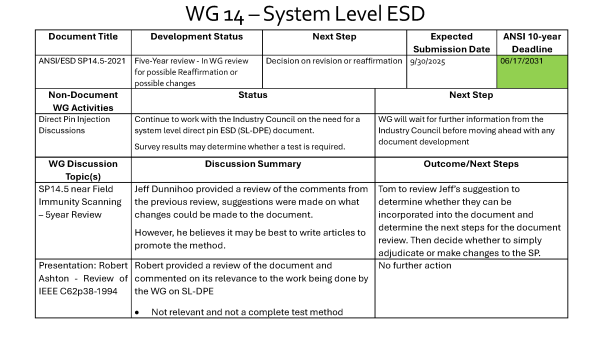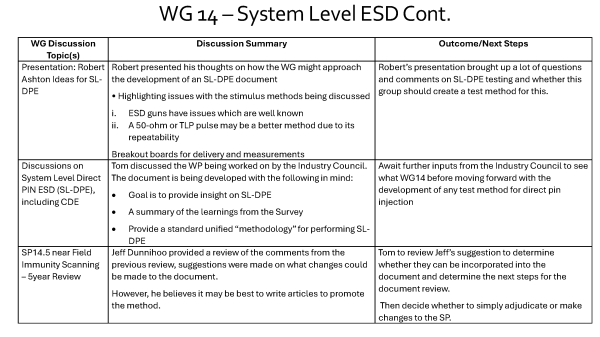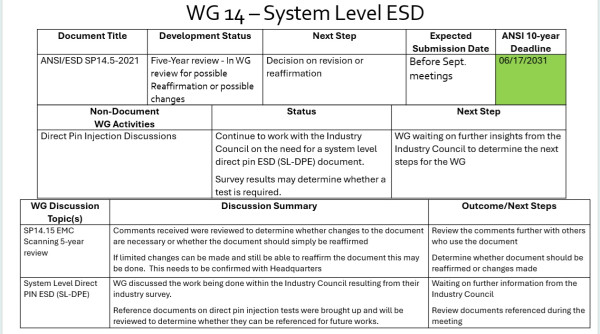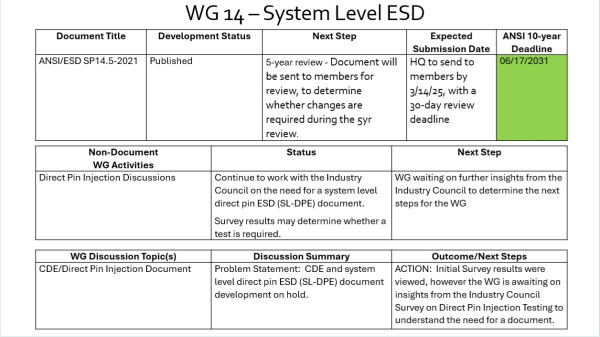WG 14.0 – System Level ESD
- Status:
- Active
- Working Group Chair:
- Thomas Meuse, Thermo Fisher Scientific
-


-

-

-
Meeting focused on a proposed Direct Pin Injection test method
- Although the IEC61000-4-2 standard states that this method should not be used directly on connector pins, device manufacturers are being asked to provide test levels on external connection pins
- Discussing Direction Pin Injection testing, brings up the question as to whether CDE (Cable Discharge Event) are simply just another stimulus type of Direct Pin Injection testing?
Industry Council Survey on Direct Pin Injection testing
- We reviewed the initial data gathered from the Industry Council to determine where the WG should go with this test method.
- It was decided we need to wait for input from the Council on the direction for the test method before moving forward.
- At the March meeting series, a decision will be made to either move forward with a CDE/Direct Pin Injection test method or, have the WG go dormant.
A suggestion had been made to write a “Position Statement” on the possible misuse of documents, however it was determined this type of document wouldn’t be considered by the “audience” it is trying to address.
-
WG14 has been tasked with examining a document regarding direct pin injection by Industry Council members focused on ESD target levels, with the group determining that awaiting the Industry Council's survey results on direct pin injection is necessary before considering any document development, emphasizing the importance of crafting a document that the industry will utilize. Additionally, the working group plans to draft a position paper addressing unrealistic test requests from misinterpretations of findings in Industry Council White Papers. This initiative responds to a specific case where a customer requested 400 stresses with an ESD gun on a component not integrated into a system, misunderstanding the intent of the 400-stress recommendation, which aimed to identify specific clock edges prone to causing soft failures in active systems.
-
The WG discussion centered around the "Direct Pin Injection" test method suggested by an industry contributor. The Industry Council is developing a questionnaire survey to gather more information on this test method, which was reviewed during the meeting. An Introduction document related to this topic has been developed and presented for reference. There was also discussion regarding a previously worked-on CDE (Charged Device Model) document, but members agreed to hold off on additional work until information from the Council's survey is gathered.
-
The meeting started with the question of what direction should this working go in. Should we go dormant?
This led to discussions on a proposed Direct Pin Injection test method.
- Although the IEC61000-4-2 standard states that this method should not be used directly on connector pins, device manufacturers are being asked to provide test levels on external connection pins.
- Discussing Direction Pin Injection testing brings up the question as to whether CDE (Cable Discharge Event) is simply another stimulus type of Direct Pin Injection testing.
Should we continue the development of a CDE document?
- With the main contributor stepping away, do we have another contributor who can step in?
- Several attendees felt there’s a need to continue the investigation into Direct Pin Injection testing.
- Follow-up survey will be sent to find out how many companies are performing this testing.
-
The WG discussed a proposed “direct pin injection” test method. The WG discussed the status of the CDE document development, focusing on how this can be moved forward. Could direct pin injection and CDE should be combined? The WG discussed the status of the IEC 61000-4-2 document and the recent changes that were being proposed. The members considered a question originally posed to the TLP WG on whether burst testing could be performed using TLP. This cannot be done due to the required repetition rate.
-
The WG discussed a proposed “direct pin injection stress” test requirement, asking to create a TR or SP. The motivation for this would be to allow everyone performing this test to perform it the same way, even though IEC states don’t perform direction pin injection. The WG also discussed the CDE document status, focusing on how this can be moved forward with the main driver stepping back from participation. The group also discussed whether direct pin injection and CDE should be combined. The WG discussed the status of the IEC 61000-4-2 document and the recent changes that were being proposed.
-
The WG discussed a proposed “direct pin injection stress” test requirement, asking that a TR or SP be created for this method. The motivation is to allow everyone having to perform this test to perform it in the same way. Most of the meeting was focused on the development of an SP on cable discharge event (CDE), including an update on a draft of the document.
-
The WG discussed a proposed “direct pin injection stress” test requirement, asking that a TR or SP be created for this method. The motivation for this is to allow everyone having to perform this test to perform it in the same way. One suggestion was to create a TR on the pitfalls of using an IEC gun to perform direct pin discharge testing, as the use of an ESD gun is a big concern for direct injection. Another suggestion was to put together an annex on “direct pin discharge” and try to get it into the IEC 61000-4-2 document which is presently under review.
Focus shifted to the development of a TR/SP on cable discharge event (CDE). A proposed draft was circulated to members. Members decided to switch to more of a system-level test method than a device-level method.
A presentation was given on inductive current probes for system ESD events. The presentation covered issues seen with certain inductive current probes and possible ways of addressing the issues using new probes.
-
The focus of the meeting was initially going to be on the development of a document for Cable Discharge Event (CDE). However, during the initial discussions a question was asked as to whether there was a requirement for “direct pin injection testing”? As this is outside on the proposed CDE method the WG needs to discuss whether a separate test method needs to be developed.
The CDE document development will be discussed in a future conference call or face to face meeting.
-
The working group announced the release of ANSI/ESD SP14.5. The group discussed and reviewed a new standard practice being developed on cable discharge event (CDE).
-
ANSI/ESD SP14.5-2021 will be published shortly after the June meeting series. The group continued reviewing and discussing a new CDE document being developed.
-
The committee adjudicated industry review comments on ESD DSP14.5. Two technical changes were made to the document, so it will be sent for a STDCOM recirculation vote before the June meeting series. The group also review and discussed the new CDE document being developed.
-
Summary of meeting activities:
The committee reviewed the status of ESD WIP14.5 (Near-Field Immunity Scanning – Component/Module/PCB Level). The committee also discussed CDE documents. A discussion was held regarding IEC-610004-2 being up for review. Any suggested changes can be submitted for consideration by the IEC committee.